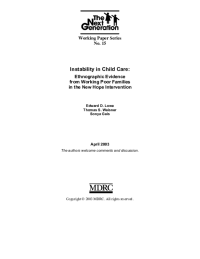Instability in Child Care
Ethnographic Evidence from Working Poor Families in the New Hope Intervention
Summary of Key Findings rom Working Paper No. 15
Background
Unstable child care arrangements can lead to negative consequences both for parents’ employment and for children’s well-being, particularly among families already struggling with low incomes and variable work schedules. This paper draws upon longitudinal ethnographic information from a sample of 44 working poor families who participated in the New Hope Demonstration, an experimental intervention in Milwaukee, Wisconsin, that provided a monthly earnings supplement, child care vouchers, and health care coverage to low-income parents if the parent worked 30 or more hours a week. The families in this study are representative of a much larger sample of families who participated in the New Hope antipoverty program. The paper examines three questions: (1) How much change and instability in child care arrangements do the families in our sample experience? (2) What features of everyday family life, and the family cultural ecology, are generally associated with change and instability? (3) How do subsidy programs available to these families like New Hope and Wisconsin Works, the state’s welfare reform initiative, promote or reduce stability of child care over time?
Key Findings
- Changing child care arrangements were pervasive, with 84 percent of sample families experiencing a change at least once in the two years of follow-up. Most importantly, between about one-third and one-half of families experienced unplanned changes in child care arrangements during the follow-up period.
- Shifts in the family cultural ecology were the most important influence on stability in child care, including, in order of importance:
– stability of work and job circumstances or in the household’s social supports;
– assistance and stability of informal care providers;
– the adequacy of material and social resources, including child care subsidies;
– consensus or conflict among family members regarding child care;
– the congruence between available child care and parents’ beliefs, goals, and values.
- Families’ descriptions of the difficulties they face meeting current child care subsidy rules and administrative hurdles suggest that modifications in the subsidy systems could render them more effective in assisting low-income working families.
Conclusions and Implications
The level of child care instability observed in this paper raises concerns. This ethnographic study extends what has been learned from previous research on child care instability by providing insight into the complex underlying reasons that account for the observed high levels of instability. The structure of subsidy policies could help mitigate some of the reasons for unplanned child care instability uncovered here. For example, child care support tied exclusively to work or income levels can lead to more instability since work is unstable in many cases. Establishing a family’s child care eligibility annually (as opposed to basing eligibility on current work effort, for example) would ensure that a child could remain in the same program for longer periods of time. These periods could be tied to school year cycles, for instance. Based on how parents talked about child care subsidies and how they responded to the current structure of the system, it is likely that, if child care supports were more stable and certain, the benefits of using child care subsidies would increase and the families’ ability to sustain their routines would improve.






